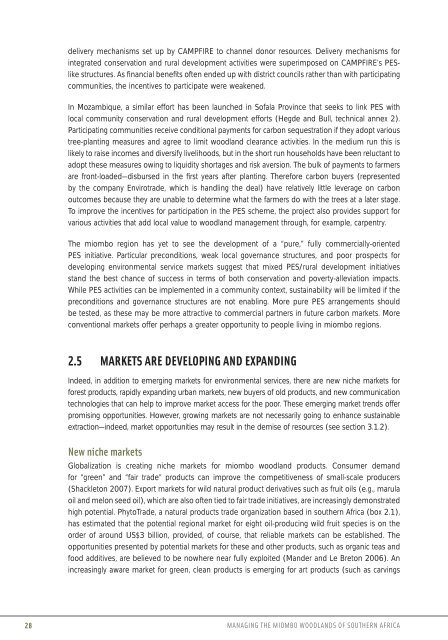Managing the Miombo Woodlands of Southern Africa - PROFOR
Managing the Miombo Woodlands of Southern Africa - PROFOR
Managing the Miombo Woodlands of Southern Africa - PROFOR
You also want an ePaper? Increase the reach of your titles
YUMPU automatically turns print PDFs into web optimized ePapers that Google loves.
delivery mechanisms set up by CAMPFIRE to channel donor resources. Delivery mechanisms for<br />
integrated conservation and rural development activities were superimposed on CAMPFIRE’s PESlike<br />
structures. As fi nancial benefi ts <strong>of</strong>ten ended up with district councils ra<strong>the</strong>r than with participating<br />
communities, <strong>the</strong> incentives to participate were weakened.<br />
In Mozambique, a similar effort has been launched in S<strong>of</strong>ala Province that seeks to link PES with<br />
local community conservation and rural development efforts (Hegde and Bull, technical annex 2).<br />
Participating communities receive conditional payments for carbon sequestration if <strong>the</strong>y adopt various<br />
tree-planting measures and agree to limit woodland clearance activities. In <strong>the</strong> medium run this is<br />
likely to raise incomes and diversify livelihoods, but in <strong>the</strong> short run households have been reluctant to<br />
adopt <strong>the</strong>se measures owing to liquidity shortages and risk aversion. The bulk <strong>of</strong> payments to farmers<br />
are front-loaded—disbursed in <strong>the</strong> fi rst years after planting. Therefore carbon buyers (represented<br />
by <strong>the</strong> company Envirotrade, which is handling <strong>the</strong> deal) have relatively little leverage on carbon<br />
outcomes because <strong>the</strong>y are unable to determine what <strong>the</strong> farmers do with <strong>the</strong> trees at a later stage.<br />
To improve <strong>the</strong> incentives for participation in <strong>the</strong> PES scheme, <strong>the</strong> project also provides support for<br />
various activities that add local value to woodland management through, for example, carpentry.<br />
The miombo region has yet to see <strong>the</strong> development <strong>of</strong> a “pure,” fully commercially-oriented<br />
PES initiative. Particular preconditions, weak local governance structures, and poor prospects for<br />
developing environmental service markets suggest that mixed PES/rural development initiatives<br />
stand <strong>the</strong> best chance <strong>of</strong> success in terms <strong>of</strong> both conservation and poverty-alleviation impacts.<br />
While PES activities can be implemented in a community context, sustainability will be limited if <strong>the</strong><br />
preconditions and governance structures are not enabling. More pure PES arrangements should<br />
be tested, as <strong>the</strong>se may be more attractive to commercial partners in future carbon markets. More<br />
conventional markets <strong>of</strong>fer perhaps a greater opportunity to people living in miombo regions.<br />
2.5 MARKETS ARE DEVELOPING AND EXPANDING<br />
Indeed, in addition to emerging markets for environmental services, <strong>the</strong>re are new niche markets for<br />
forest products, rapidly expanding urban markets, new buyers <strong>of</strong> old products, and new communication<br />
technologies that can help to improve market access for <strong>the</strong> poor. These emerging market trends <strong>of</strong>fer<br />
promising opportunities. However, growing markets are not necessarily going to enhance sustainable<br />
extraction—indeed, market opportunities may result in <strong>the</strong> demise <strong>of</strong> resources (see section 3.1.2).<br />
New niche markets<br />
Globalization is creating niche markets for miombo woodland products. Consumer demand<br />
for “green” and “fair trade” products can improve <strong>the</strong> competitiveness <strong>of</strong> small-scale producers<br />
(Shackleton 2007). Export markets for wild natural product derivatives such as fruit oils (e.g., marula<br />
oil and melon seed oil), which are also <strong>of</strong>ten tied to fair trade initiatives, are increasingly demonstrated<br />
high potential. PhytoTrade, a natural products trade organization based in sou<strong>the</strong>rn <strong>Africa</strong> (box 2.1),<br />
has estimated that <strong>the</strong> potential regional market for eight oil-producing wild fruit species is on <strong>the</strong><br />
order <strong>of</strong> around US$3 billion, provided, <strong>of</strong> course, that reliable markets can be established. The<br />
opportunities presented by potential markets for <strong>the</strong>se and o<strong>the</strong>r products, such as organic teas and<br />
food additives, are believed to be nowhere near fully exploited (Mander and Le Breton 2006). An<br />
increasingly aware market for green, clean products is emerging for art products (such as carvings<br />
28 MANAGING THE MIOMBO WOODLANDS OF SOUTHERN AFRICA

















